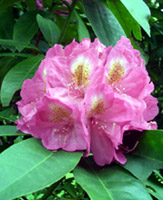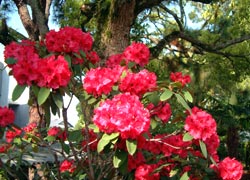 Botanical name:Rhododendron arboreum Sm.
Botanical name:Rhododendron arboreum Sm.
Rhododendron barbatum Wall.
Rhododendron campanulatum D.Don.
Rhododendron cinnamoneum Wall.
Rhododendron decipiens Lacaita.
Rhododendron falconeri Hook f.
Rhododendron milagiricum Zerk.
Rhododendron thomsonii Hook f.
Family name:Ericaceae.
Indian names are as follows:
Hindi, Nepali, Garhwali, Kumauni, Dogri:Gnuras, Langnurash
Meitei:Leihao.
The plants are basically large shrubs growing up to a meter with large beautiful flowers resembling rose but without aroma, and thick large eye shaped leaves. The flowers appear during autumn makes the hills colorful. In Nepal, it is considered as national flower as well as sacred since it is offered to the famous deity Pashupatinath.
Tinctures and extracts of Rhododendron species have cardiac effects on cats like those of digitalis glucoside. Leaves of Rhododendron decipiens species yield campanulin, friedelin, ursolic acid and quercetin. A poisonous principle acetylandromedol isolated from Rhododendron thomsonic. The honey from all varieties of these species is poisonous to human beings.
 As narrated above this plant is normally not considered as source of spices. However, in Nepal, North Bengal, Sikkim and North Eastern India, its fresh flowers are added to meat preparations as spice. It is believed that it helps in quick cooking of meat and gives unique taste and flavor. In Uttaranchal too it is used in same way. It may be considered if this use be popularized so that fresh flowers may be packed appropriately and marketed or dehydrated flowers be transported for use as spice.
As narrated above this plant is normally not considered as source of spices. However, in Nepal, North Bengal, Sikkim and North Eastern India, its fresh flowers are added to meat preparations as spice. It is believed that it helps in quick cooking of meat and gives unique taste and flavor. In Uttaranchal too it is used in same way. It may be considered if this use be popularized so that fresh flowers may be packed appropriately and marketed or dehydrated flowers be transported for use as spice.
In Nepal, the folk physicians use this as herb for treatment of piles, leucorrhoea, intestinal worms, diabetes, oedema, diseases of liver and spleen.
The herb is not commercially important or popular as spice today. Its application as spice needs to be popularized not only to bring in new types of preparations but also to popularize the spice as commercially important spice. It will also help in growth of a number of processing centers for manufacture of such new types of spice.
The knowledge of folk physicians of Nepal can effectively be utilized this herb can ensure growth of a number of medicinal manufacturing units. This can ensure growth of units that shall give us new type of medicines for global and domestic market.
The honey from these plants is poisonous for human consumption. But it can safely be used for external applications. It can be used for manufacture of cosmetics and medicinal preparations meant for external use.




















